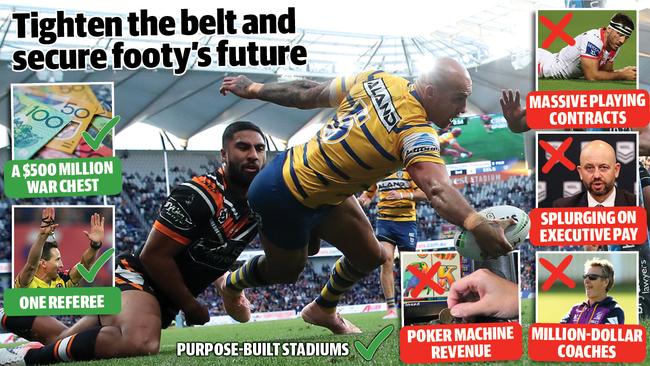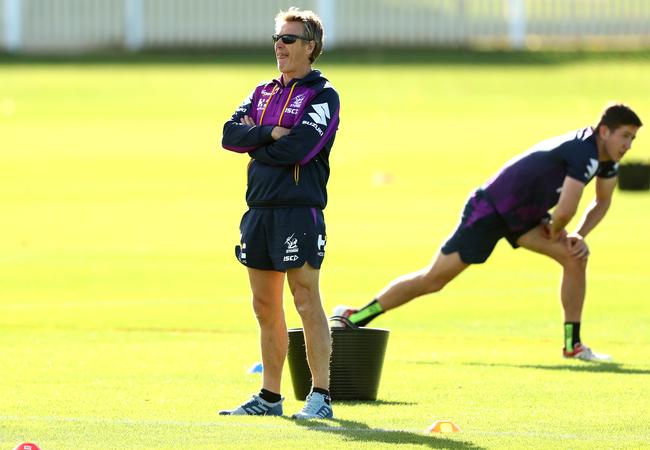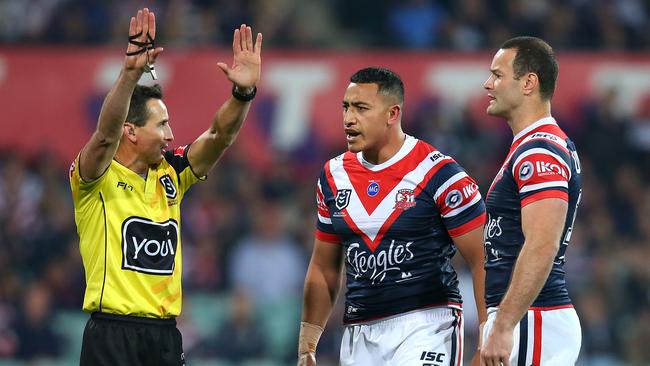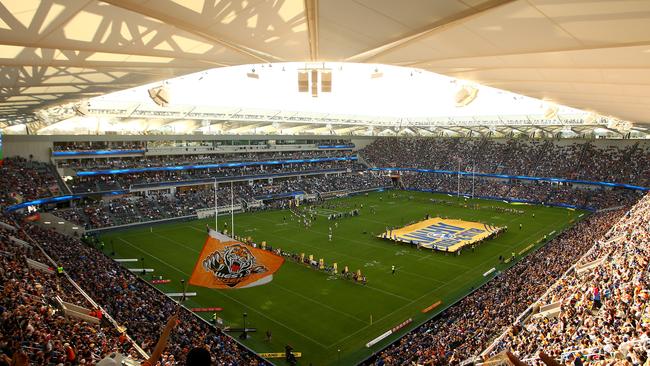Phil Rothfield: How NRL will cut $50m a year
ARLC chairman Peter V’landys has vowed to cut $50 million a year in costs. Here’s how it will be done, writes Sports Editor-at-large Phil Rothfield.
NRL
Don't miss out on the headlines from NRL. Followed categories will be added to My News.
The NRL’s financial position is no longer catastrophic.
A soon-to-be-signed seven-year, $2.3 billion TV broadcast deal is the richest in Australia’s sporting history and gives the NRL a wonderful foundation to safeguard its future.
The game now needs a seven-year strategic plan, driven and delivered by Peter V’landys, and long-term investment must be the number one priority.
Combine the annual $330 million payment from Channel 9 and Fox Sports with another $200 million in non-broadcast revenue and the game has a solid base.
Relive classic NRL matches from the 60s to today on KAYO SPORTS. New to Kayo? Get your 14-day free trial & start streaming instantly >
The clubs get $206 million (16 x $13 million grants), which takes care of player payments and leaves each franchise $3 million in change before sponsorship, membership, ticket sales, merchandise and leagues club grants.
That leaves $324 million for the NRL each year. And this is what needs to happen.

SALARIES
Cost-cutting will start at the top and the next CEO will be on lower than $1 million.
Recently departed chief executive Todd Greenberg was on $1.2 million plus big bonuses.
It was recently revealed the NRL spends $500,000 a day to run the competition with a staff of 400.
V’landys has vowed to slash $50 million a year from these costs. Executive wages have been out of control for too long. The game’s senior management team is on a combined $6 million.
The likes of second-in-charge Nick Weeks will no longer be on $900,000.

CLUBS
Poker machine revenue is slowly dying and Sydney teams can no longer rely on their licensed clubs.
Still, the NRL must not give the clubs more money. It’s like drip-feeding cash to a drunk punter.
These clubs have lost and squandered almost $400 million over the past 10 years.
We reported recently how the money has been wasted on dozens of coach sackings, overstaffing of football departments, player contract payouts and salary cap scandals.
Like the NRL head office, the clubs need to spend more responsibly and set up sustainable business models.
MORE BUZZ: Cash-strapped NRL on verge of $2.3b pay day
MORE BUZZ: ABC to probe NRL financial woes
MORE BUZZ: Meet NRL’s wonder WAG
FOOTBALL DEPARTMENTS
Salaries for coaches and their high-performance staff will be substantially reduced.
The days of Craig Bellamy and Wayne Bennett getting $1.5 million are numbered. It is simply unaffordable.
Some clubs are now spending up to $8 million to prepare their teams. The NRL will impose a cap of around $4.5 million on football departments.
There will be two assistant coaches instead of three, one less physio and one less in sports science. The extravagance of having full-time dietitians, psychologists and two doctors will go.

PLAYER PAYMENTS
Goodbye to Ben Hunt, Ash Taylor, Josh Dugan, Kieran Foran and Anthony Milford-type contracts.
The salary cap is now $9.6 million and the RLPA will fight hard for increases each year.
However, there is talk that players will have to take a hit like everyone else.
One official told me the cap could come down to as low as $8.5 million next year while the game, like all businesses, slowly recovers from COVID-19. It would require an across-the-board pay cut of 11 per cent.

GRASSROOTS
To save money, the responsibility for junior development needs to be taken from the clubs.
In some cases, like at the Penrith Panthers, it will save them several million dollars annually.
In the past the NRL, NSWRL and clubs have all employed development officers in schools and junior league.
Ridiculously, representatives from all three bodies have been covering the same areas.
Clubs will be reluctant to lose control of their own juniors but it is the most cost-effective outcome.
In future, this should all be handled by the NSWRL and QRL. All juniors will belong to the game, not the individual clubs.
REFEREES AND BUNKER
The NRL employs 25 full-time referees and touch judges.
The Project Apollo committee has already determined the game will resume on May 28 with only one referee. The full-time squad could drop to as low as a dozen.
There are many cost-saving opportunities for The Bunker, including combining operations with other football codes such as the AFL, rugby union and soccer to share the same technology from the same facility. It could save $2 million a year.

INTEGRITY UNIT
The integrity unit employs 17 investigators, legal experts and betting analysts.
This is another area where cost savings could be significant.
Like with the operation of The Bunker, there is talk of setting up a statewide sporting integrity unit to be in charge of all sports in NSW, including cricket, the football codes, boxing or any events on which bookmakers frame markets.
INDEPENDENT COMMISSION
Now is the time for a shake-up. To ensure transparency, the 16 clubs should have two representatives on the commission.
There would be no more secrets over finances. Only COVID-19 uncovered the mess we’ve been in.
Also the QRL and NSWRL should each have a representative at the table now they have taken full responsibility for grassroots.
STADIUM POLICY
The NRL has to finalise a policy on venues and take it to the state government. Maybe even buy or invest in a stadium like Bankwest.

Greenberg always favoured the big stadium rebuilds at Allianz and ANZ, which is fine for Origin, grand finals and blockbusters.
But V’landys is in favour of suburban-ground tribalism, as are the broadcasters, which loathe having a backdrop of tens of thousands of empty seats.
The nine Sydney clubs can only survive long term if several of the venues, such as Brookvale Oval, Shark Park, Leichhardt Oval, Campbelltown, Kogarah and Penrith, are upgraded into boutique stadiums or mini Bankwest Stadiums.
INVESTMENT
The NRL right now owns nothing.
It recently obtained a $250 million line of credit from UK financiers as an emergency backstop to fight the crippling effect of COVID-19.
V’landys wants to build a war chest. The aim is to bank or invest $70 million a year.
That would leave more than half a billion dollars in the bank by the time this next broadcast deal expires in 2027. And it would set the game up for the next 50 years.
Originally published as Phil Rothfield: How NRL will cut $50m a year



